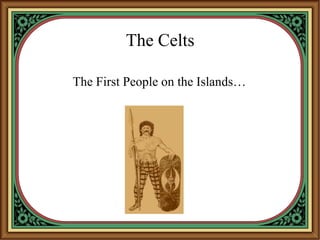Report
Share

Recommended
Recommended
More Related Content
What's hot
What's hot (20)
Similar to The celts j6
Similar to The celts j6 (20)
Stone Age, Bronze Age, Iron Age, Celtic and Early Christian Ireland

Stone Age, Bronze Age, Iron Age, Celtic and Early Christian Ireland
More from Pato_Ch
More from Pato_Ch (20)
Written near a port on a dark evening charlotte smith

Written near a port on a dark evening charlotte smith
The pains of sleep by samuel taylor coleridge (bianca, juana and sol)

The pains of sleep by samuel taylor coleridge (bianca, juana and sol)
Recently uploaded
Recently uploaded (20)
Unit-IV; Professional Sales Representative (PSR).pptx

Unit-IV; Professional Sales Representative (PSR).pptx
Food safety_Challenges food safety laboratories_.pdf

Food safety_Challenges food safety laboratories_.pdf
ICT role in 21st century education and it's challenges.

ICT role in 21st century education and it's challenges.
Fostering Friendships - Enhancing Social Bonds in the Classroom

Fostering Friendships - Enhancing Social Bonds in the Classroom
Vishram Singh - Textbook of Anatomy Upper Limb and Thorax.. Volume 1 (1).pdf

Vishram Singh - Textbook of Anatomy Upper Limb and Thorax.. Volume 1 (1).pdf
General Principles of Intellectual Property: Concepts of Intellectual Proper...

General Principles of Intellectual Property: Concepts of Intellectual Proper...
Kodo Millet PPT made by Ghanshyam bairwa college of Agriculture kumher bhara...

Kodo Millet PPT made by Ghanshyam bairwa college of Agriculture kumher bhara...
Python Notes for mca i year students osmania university.docx

Python Notes for mca i year students osmania university.docx
The celts j6
- 1. The Celts The First People on the Islands…
- 2. The name 'Iron Age' comes from the discovery of a new metal called iron.
- 3. Celtic Tribes in Britain and Ireland
- 4. How do we know information about the Celts? Archaeologists are always trying to find evidence but sometimes it gets found accidently. Some workmen came across a body. The man had been killed 2000 years ago – they still found food in his stomach! His last meal was bread.
- 5. The Celts The Celts lived across most of Europe during the Iron Age. People had lived in Britain for thousands of years before the Romans arrived. The Celts lived in roundhouses with thatched roofs of straw or heather (plant that grows on the hills of northern Britain). In places where there were plenty of trees the walls were made out of wattle and daub (hazel trees with clay and straw).
- 6. In the North of Britain they used large stones and clay to make the walls. This is a roundhouse being built. There are poles to hold up the thatched roof. The settlements are protected by a stone wall with wood.
- 8. The settlements Families lived together in settlements: children, parents, grandparents, aunts, uncles and cousins. The roundhouses were built in groups. The walls protected them from wolves and wild boar. Sometimes groups of houses were built on the top of hills. These were called hill-forts.
- 9. For defensive purposes, the Celtic village was sometimes made part of a hill fort.
- 10. Celts and personality • Emotional, passionate, heroic, wild, and drunken Sensual, artistic, hospitable, instinctual Proud, inventive, battle-loving They were farmers and traders and also did some agriculture They traded metals, salt, pottery, glass and coin ornaments
- 11. However, there was always the constant danger of warfare with another tribe. Therefore, Celtic men were trained as warriors.
- 12. Their basic weapons were the shield and the long sword
- 13. They also had cavalry, who could carry multiple spears. But, they were best known for their skill with the chariot.
- 14. Religion Believed in the “otherworld” Believed in many Gods (pagans)
- 15. Sacrifice In battle they would cut peoples heads off and carry it around. They were trophies to them, which symbolized courage and bravery.
- 16. Druids They were members of the learned/knowledgeable class among the ancient Celts. They could stop a battle. Responsibilities included: teaching the religious doctrine, medicine, civil justice, sacrifice, divination, and care of temples. To become a druid, school would take up to 20 years because it all had to be memorized They performed animal and human sacrifices and practiced divination and other forms of magic
- 17. The Celts were happy on their island home. But, everything was about to change with the coming of the Romans…
